Click on the above“Material Person” to subscribe to us
Introduction
In an era of rapidly increasing demand for portable electronic devices, the need for power components that are easy to carry, lightweight, and sustainably rechargeable has become quite urgent. Currently commercialized energy storage devices like lithium-ion batteries can only provide power levels from μW to mW in electronic devices, while also facing issues of large size, heavy weight, and limited lifespan. However, self-charging power units (SCPU) that combine energy collection and storage functions show unique advantages, including lightweight, high charge output, and exceptional portability.
Results Overview
Recently, Professor Hu Chengguo from Chongqing University and Professor Wang Zhonglin from Georgia Institute of Technology (co-corresponding authors) published an article titled “Ultralight Cut-Paper-Based Self-Charging Power Unit for Self-Powered Portable Electronic and Medical Systems” in ACS Nano, introducing their latest progress in ultralight self-charging units. They designed a modular cut-paper structure self-charging power module (PC-SCUPU), which, when combined with a paper-based triboelectric nanogenerator (TENG) or supercapacitor (SC), can achieve the goal of simultaneously collecting and storing energy through human body movement.
Illustrative Guide
Figure 1. Schematic diagram of the modular cut-paper structure self-charging power module
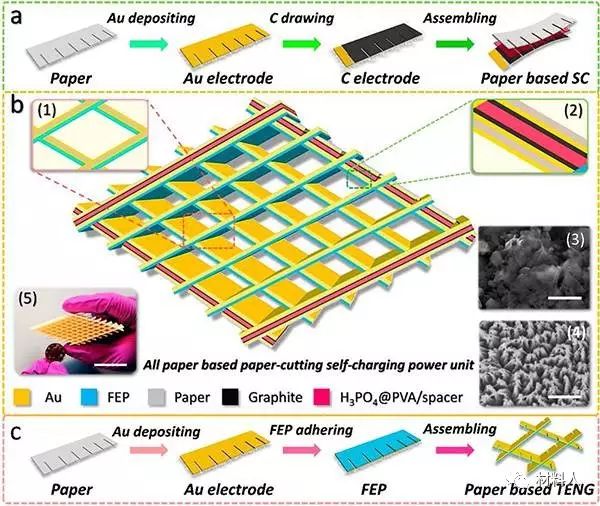
a. Preparation process of paper-based supercapacitors (P-SC)
b. Structural scheme of P-SC
c. Production process of paper-based triboelectric nanogenerator (PC-TENG)
Figure 2. Working mechanism of PC-TENG
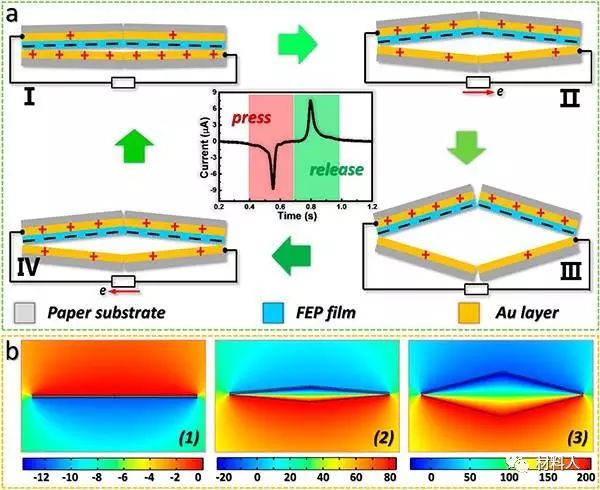
a. Charge distribution diagram of PC-TENG under short-circuit conditions
b. Numerical calculations of the electrode potential distribution of PC-TENG under open-circuit conditions for steps 1-3, using COMSOL physics simulation software
Figure 3. Performance testing of PC-TENG in collecting mechanical energy
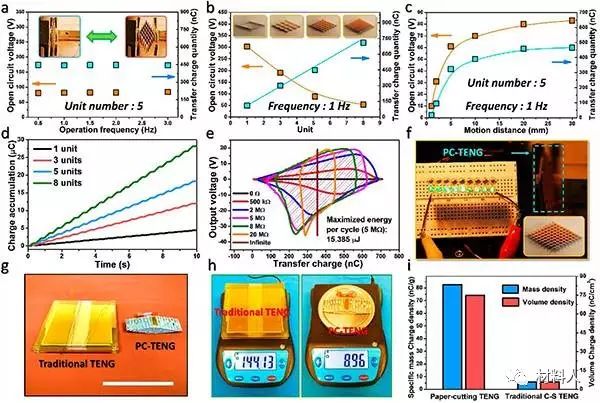
a. Measurement of open-circuit voltage (VOC) and short-circuit current (QSC) of PC-TENG at different frequencies (0.5−3.0 Hz)
b. Measurement of VOC and QSC of PC-TENG with different unit numbers (1×1 to 8×8)
c. Measurement of VOC and QSC of PC-TENG at different separation distances (1−30 mm)
d. Measurement of charge accumulation of different numbers of PC-TENG units with the help of a rectifier
e. V-Q curve testing of 8 PC-TENG units connected to various external loads
f. Photo of 8 power units connected to an LED
g. Photos comparing traditional TENG (output charge 820nC) and PC-TENG (output charge 740nC)
h. Weight comparison of 8 traditional TENG and PC-TENG
i. Comparison of mass density (nC/g) and volume output charge (nC/cm3) of traditional TENG and PC-TENG
Figure 4. Performance testing of P-SC in energy storage
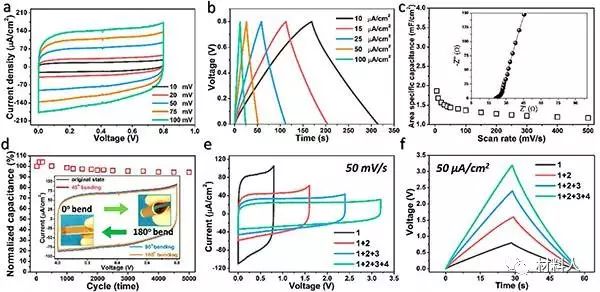
a. C-V curve testing of P-SC at different scan rates (10−100 mV/s)
b. Constant current charge-discharge curves (C/D curves) of P-SC at different current densities (10−100 μA/cm2)
c. Surface capacitance testing of P-SC at different scan rates (10−600 mV/s); inset shows the electrochemical impedance of P-SC
d. Stability testing of 5000 charge-discharge cycles; inset shows CV curve testing at different bending angles
e. CV and C/D curves of complete P-SC formed by different unit numbers (1-4) in series
Figure 5. Practical applications of PC-SCPU portable power supply
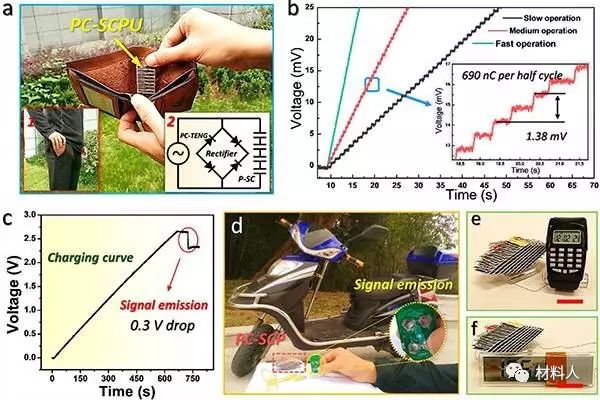
a. Application of PC-SCPU in a wallet. Inset 1 shows that the ultralight PC-SCPU can easily fit in a pocket. Inset 2 is the circuit diagram of PC-SCPU
b. V-T testing curve when tapping the PC-SCPU
c. V-T testing curve while driving a wireless remote control in charging mode
d. Application of PC-SCPU in remote control
e. Digitally powered electronic watch made using PC-SCPU
f. Thermometer powered by PC-SCPU
Conclusion
This PC-SCUPU concept has been experimentally proven to perform well in energy collection and storage. The ultralight diamond-shaped TENG assembled with paper as the substrate has a high specific surface area and unit volume charge storage, successfully operating in wallets, remote controls, and portable electronic devices. This research demonstrates the application potential of paper-based self-charging energy units, especially in medical science with vast prospects for disposable uses.
Original Link:Ultralight Cut-Paper-Based Self-Charging Power Unit for Self-Powered Portable Electronic and Medical Systems(ACS Nano,. 2017, DOI: 10.1021/acsnano.7b00866) (See below “Read Original”)
This article is contributed by the New Energy Group of Material Person, edited by Material Cow. To participate in discussions on new energy topics, please join the “Material Person New Energy Material Exchange Group 422065952”.
Material Cow focuses on tracking technological and industrial progress in the field of materials, gathering graduate and doctoral students from major universities, frontline researchers, and industry practitioners. If you are interested in tracking technological progress in the field of materials, interpreting high-level articles, or commenting on the industry, click below “Read Original” to join the editorial department of Material Cow.

Long press the QR code to subscribe to Material Person for more technology services
Cooperation Contact
Testing Valley: The Material Person’s one-stop material analysis testing solution platform has been revamped! Material Testing Data Analysis Testing Valley(http://www.ceshigu.com/)
Testing Services:XRD/TEM/SEM/DSC/AFM/Mechanical Testing/Thermal Analysis/PPMS/Infrared/Particle Size Analysis
Technical Services:Paper polishing/Paper drawing/Theoretical calculation/EBSD data analysis/MS usage guidance/TEM operation guidance……
Business Cooperation: 15120014412
Email: [email protected]
Material Person is waiting for you here